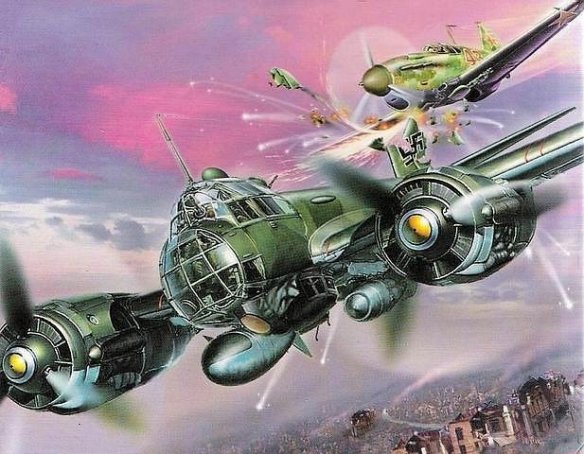Moscow, as expected, became the main target for enemy air attack. Hitler’s intention to level Moscow required hundreds of bombing planes. For this purpose the Luftwaffe formed a special group of 1,600 aircraft made up of the best squadrons. The leaders of this air fleet, which provided support for the Wehrmacht’s Army Group Centre, chose bombers of the newest types, including the Heinkel-111 with high altitude engines, the Junkers-88, and the Dornier-215. Pilots in these raids were picked from famous squadrons, including the `Condor’, which had bombed Spanish cities including the Basque town of Guernica during the civil war, and others that had menaced the skies over London, Liverpool and Birmingham, or operated over Poland, Yugoslavia and Greece. Moscow is an old city and its main thoroughfares are arranged in concentric circles – easily identifiable to unfriendly aircraft. To counter this, architects and artists altered Moscow’s appearance. Roofs of houses were painted so they looked like a `continuation’ of streets; many squares `disappeared’. Rivers on starry or moonlit nights can be easily recognized from the air. To alter the landscape, when darkness set in, barges with camouflage nets were moored at specific points on the Moscow River. `New bridges’ appeared and old bridges `disappeared’ under smokescreens and other means of subterfuge.
In the first month of war the Luftwaffe made nearly 100 attempts to penetrate the skies over Moscow, clandestinely, one at a time, at a height of 8,000 metres (24,000 feet). Only a few planes got through. Between July and December 1941 there were approximately 120 raids against Moscow comprising over 7,000 Luftwaffe planes. Of this number only about 200 German aircraft succeeded in getting close to the capital. The rest were shot down or chose less forbidding targets. In the July-August period nine enemy bombers were lost due to ramming. Moscow’s air defence proved to be of a high order.
On July 2, something unexpected happened. A Heinkel-111, equipped with a high-altitude engine, flew towards Moscow on an intelligence-gathering mission. On board was a colonel from the German General Staff who carried with him important documents including operational maps and codes. His aircraft was met by a Yak-1 piloted by Lieutenant Sergei Goshko. The Yak-1 was a wooden-winged plane with a top speed of over 450 kilometres per hour (279 miles per hour) which could outmanoeuvre some of the Luftwaffe’s faster planes. Suddenly, after an indecisive aerial battle, the Russian pilot struck off the tail of the Heinkel with the wing of his fighter, sending the intruder spinning to earth. For his exploit, Goshko was decorated with the highest combat medal, the gold hero’s medal. Goshko brought down six more German aircraft by conventional means, making his last flight over a defeated Berlin on May 8, 1945.
To safeguard Moscow as well as other cities, Russian pilots rammed Luftwaffe planes on at least 300 occasions during the war. Many of these rammings took place on the approaches to the capital.
On the night of July 22, 1941 Hitler launched his first massive air strike against Moscow, 220 bombers taking part. Marshal Zhukov says that only a small percentage of the enemy bombers reached the capital, most of the others being stopped by the Moscow Anti-Aircraft Defence System. About two dozen bombers were shot down outside the capital. This became the first of a series of aerial battles for command of Moscow’s skies.
Erskine Caldwell, the American author of Tobacco Road, was in Moscow during the first month of the war and witnessed a series of air raids. This is how he described the night of July 23/24, 1941: `I am unable to compare Moscow’s air defence with that of London and Berlin; but judging from reports, if the Moscow defence is not superior it certainly must be every bit as effective in beating back air attacks as any air defence anywhere.’ After watching repeated air raids, Caldwell said that in five nights of raiding Moscow the intruders `have accomplished little more than the entire Swiss Navy accomplished in the First World War’.
